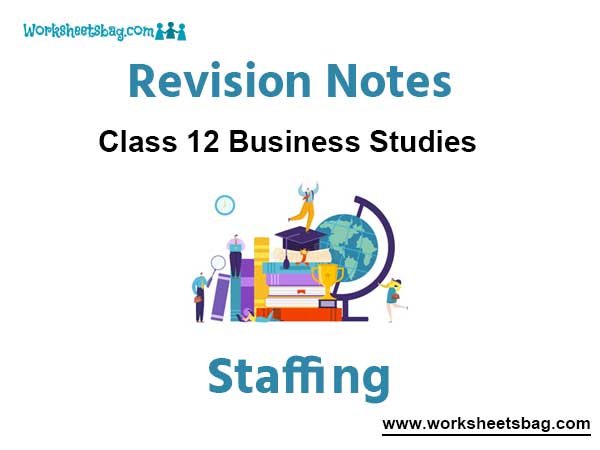Please refer to the Staffing Notes Class 12 Business Studies given below. These revision notes have been designed as per the latest NCERT, CBSE, and KVS books issued for the current academic year. Students will be able to understand the entire chapter in your class 12th Business Studies book. We have provided chapter-wise Notes for Class 12 Business Studies as per the latest examination pattern.
Revision Notes Chapter 6 Staffing Class 12 Business Studies
Students of Class 12 Business Studies will be able to revise the entire chapter and also learn all important concepts based on the topic-wise notes given below. Our best teachers for Grade 12 have prepared these to help you get better marks in upcoming examinations. These revision notes cover all important topics given in this chapter.
Staffing
Once the organisational goals are set up, plans are prepared and organisation is appropriately structured to pave the path for achieving of the set goals.
Meaning:
Staffing is a managerial function of filling and keeping filled, the positions in the organisation structure.
Importance of Staffing :
Obtaining Competent Personnel: Proper staffing helps in discovering and obtaining competent personnel for various jobs.
High Performance: Proper staffing ensures higher performance by putting right person on the right job.
Continuous growth: Proper staffing ensures continuous survival and growth of the enterprise.
Optimum utilization of human resources: It prevents under-utilization of personnel and high labour cost.
Improves job satisfaction: It improves job satisfaction and morale of employee.
STAFFING PROCESS :
The steps in the staffing process is as under.
• Estimating manpower requirement
• Recruitment
• Selection
• Placement and Orientation
• Training and development
• Performance appraisal
• Promotion
• Compensation
1. Estimating Manpower Requirement
Work load Analysis is done to know about number and types of human resources required for the performance of various jobs.
Work force Analysis is done to know about number and types of human resources available in the organization. This will help to know if organisation is overstaffed or understaffed.
2. RECRUITMENT
Recruitment refers to the process of searching for prospective employees and stimulating them to apply for jobs in the organization. It is a positive process, because pool of candidates is created. Higher the number of applicants, greater is the possibility of finding a suitable employee.
3. Selection: It is the process of choosing and appointing the right candidates for various jobs in an organization through various exams, tests & interviews. It is a negative process as only a few are selected.
4. Placement and Orientation: It is concerned with the process of introducing a new employee to the organization. Orientation/Induction is concerned with the process of introducing a new employee to the organization. The rules and regulations are also imparted.
5. Training and Development: Systematic training helps in increasing the skills and knowledge of employees in doing their jobs through various methods. Development involves growth of an employee in all respects. It is the process by which the employees acquire skills and competence to do their present jobs and increase their capabilities for higher jobs in future.
6 Performance Appraisal: It is concerned with rating or evaluating the performance of employees. Transfers and promotions of the staff are based on performance appraisal.
7. Promotion and career planning: They must encourage employees to grow and realise their full
potential. Promotions are an integral part of people’s career.
8. Compensation: Compensation refers to all forms of pay or rewards going to employees. All organisations need to establish wage and salary plans for their employees.
Sources of Recruitment
There are two sources of Recruitment
1. Internal Sources
2. External Sources
Internal Sources of Recruitment
Internal sources refer to inviting candidates from within the organisation. Following are important sources of internal recruitment:
1. Transfers: It involves the shifting of an employee from one job to another, from one department to another or from one shift to another shift.
2. Promotions: It refers to shifting an employee to a higher position carrying higher responsibilities, prestige, facilities and pay.
INTERNAL SOURCES :
MERITS :
• Employees are motivated as they will get promotion.
• It is a simple process as no cost is necessary.
• As there is chance for higher job, employees may be preparing for higher jobs
• Shifting workforce from the surplus departments is economical.
LIMITATIONS :
• No fresh talent or fresh blood will be there.
• Employees become lethargic as they are sure of getting the job.
• Internal sources not sufficient sometimes for more growth.
• Frequent transfers of employees effects the business.
EXTERNAL SOURCES OF RECRUITMENT :
When the candidates from outside the organization are invited to fill the vacant job position then it is
known as external recruitment. The common methods of external sources of recruitments are:
• Direct Recruitment
• Casual Callers
• Advertisement
• Employment Exchange
• Placement Agencies
• Management Consultants
• Campus Recruitment
• Recommendations of Employees
• Labour Contractors
• Advertising on Television
• Web Publishing etc.
1. Direct Recruitment: Under the direct recruitment, a notice is placed on the notice board of the enterprise specifying the details of the jobs available.
2. Casual callers: Many reputed business organizations keep a data base of unsolicited applicants in their office. This list can be used for Recruitment.
3. Advertisement: Advertisement in media is generally used when a wider choice is required. Example– Newspapers, Internet, Radio, Television etc.
4. Employment Exchange: Employment exchange is regarded as a good source of recruitment for unskilled and skilled operative jobs.
5. Placement Agencies: The job seekers can register in the Placement Agencies .The organization which needs candidates approaches these agencies.
6 Management Consultants : Management consultancy firms help the organisations to recruit technical, professional and managerial personnel. They Maintain data bank of persons with different qualifications and skills. The organization which needs candidates approaches these agencies.
7. Campus Recruitment: Many big organisations maintain a close liaison with the universities, vocational schools and management institutes to recruit qualified personnel
for various jobs.
8. Recommendations of Employees: Applicants introducedby present employees, or their friends and relatives may prove to be a good source of recruitment. Such applicants are likely to be good employees because their background is sufficiently known.
9. Labour Contractors: Labour contractors maintain close contacts with labourers and they can provide the required number of unskilled workers at short notice.
10. Advertising on Television: The detailed requirements of the job and the qualities required to do it are publicised alongwith the profile of the organisation where vacancy exists.
11. Web Publishing: websites such as www.naukri.com, www. jobstreet.com etc., are very commonly visited both by the prospective employees and the organisations searching for suitable people.
Merits of External Sources
Qualified Personnel: By using external source of recruitment the management can attract qualified and trained people to apply for the vacant jobs in the organization.
Wider Choice: The management has a wider choice in selecting the people for employment.
Fresh Talent: It provides wider choice and brings new blood in the organization.
Competitive Spirit: If a company taps external sources, the staff will have to compete with the outsiders.
Limitations of External Sources of Recruitment
Dissatisfaction among existing employees: Recruitment from outside may cause dissatisfaction among the employees. They may feel that their chances of promotion are reduced.
Costly process: A lot of money has to be spent on advertisement therefore this is costly process.
Lengthy Process: It takes more time than internal sources of recruitment.
PROCESS OF SELECTION :
• Preliminary Screening
• Selection Tests
• Employment Interview
• Reference and Background Checks
• Selection Decision
• Medical Examination
• Job Offer
• Contract of employment
1. Preliminary Screening: After applications have been received, they are properly checked as regarding qualification etc. by screening committee. A list of candidates to be called for employment tests made and unsuitable candidates are rejected altogether.
2. Selection Tests: These tests include:
(a) Psychological tests which are based on assumption that human behaviour at work can be predicted by giving various tests like aptitude, personality test etc.
(b) Employment test for judging the applicant’s suitability for the job.
3. Employment Interviews: The main purpose of interview is:
(a) to find out suitability of the candidates.
(b) to seek more information about the candidate.
(c) to give the candidate an accurate picture of job with details of terms and conditions.
4 Reference Checks: Prior to final selection, the prospective employer makes an investigation of the references supplied by the applicant. He undertakes a thorough search into candidate’s family background, past employment, education, police records etc.
5. Selection Decisions: A list of candidate who clear the employment tests, interviews and reference checks is prepared and then the selected candidates are listed in order of merit.
6. Medical/Physical Examination: A qualified medical expert appointed by organization should certify whether the candidate is physically fit to the requirements of a specific job. A proper physical exam will ensure higher standard of health & physical fitness of employees thereby reducing absenteeism.
7. Job Offer: After a candidate has cleared all hurdles in the selection procedure, he is formally appointed by issuing him an Appointment Letter. The broad terms
and conditions, pay scale are integral part of Appointment Letter.
8. Contract of Employment: After getting the job offer, the candidate has to give his acceptance. After acceptance, both employer and employee will sign a contract of employment which contains terms & conditions, pay scale, leave rules, hours of work, mode of termination of employment etc.
Some Common Selection Tests:
• Intelligence Test – to measures the level of intelligence quotient
• Aptitude Test – to find out the potential of candidate of learning new skills and methods.
• Personality Test – to find out the behaviour, intelligence, aptitude, attitude and interest of candidate.
• Trade Test – to check the existing skills, knowledge and proficiency of candidate.
• Interest Test – to check the interest of candidate in the job.
Training
Training is the act of increasing the knowledge and technical skills of an employee for doing a particular job efficiently.
Both existing employees and new employees get acquainted with their jobs and this increases job related skills.
It is essential part of job which is helpful in improving the knowledge of an individual. The nature of jobs has changed with the changes in business environment
IMPORTANCE/BENEFITS of TRAINING AND DEVELOPMENT
Benefits to employee
1. Training provides the employee with the skills to grow in the career. It is helpful in improving knowledge of the processes which is essential for future growth.
2. An individual with training will be able to earn more than those without any kind of training. It improves the working efficiency and results in good performance.
3. Training makes an employee more confident of handling a work. The equipment’s and machines at workplace will be easier to manage with proper training. There will be less accidents.
4. Training improves the self-confidence of the employees and helps them to face new challenges in work. The increased confidence also contributes to the sense of feeling of a higher job satisfaction.
Benefits for organization
1. Training is a systematic way of teaching processes. It will be therefore more efficient and saves the organisation time and money.
2. Training helps individuals and makes them more efficient; the direct result is the improvement in productivity. The rise in employee productivity will result in growth of the company.
3. Training helps in preparing employees in facing new challenges and situations. It helps in building an effective way to counter issues that arise in future.
4. A good training helps in boosting employee morale. It gives proper confidence and motivation which reduces the employee turnover and absenteeism from work.
Training Methods
(A) On the Job Method: It refers to the methods that are applied at the work place, where the employee is actually working. It means learning while doing.
The following are the methods of On-the job training
(B) Off-the-job training methods are conducted in separate from the job environment, study material is supplied, there is full concentration on learning rather than performing, and there is freedom of expression.
ON THE JOB: Induction Apprenticeship
Internship training.
OFF THE JOB:
Vestibule training
INDUCTION TRAIING :
APPRENTICESHIP TRAINING: This type of training is need for the skilled jobs such as plumber, fitter, electrician etc. In this method trainees are put under a master worker.
APPRENTICESHIP TRAINING: This type of training is need for the skilled jobs such as plumber, fitter, electrician etc. In this method trainees are put under a master worker.
INTERNSHIP TRAINING: This type of training is provided jointly by educational institutions and business organizations. A student carry his classes in the educational institution, and at the same time he makes practice with the business organization to get practical training.
VESTIBULE TRAINING: In this method actual work environment is created in the class room and the trainees use same material and equipment as used in the factory. This is done in the cases where employees are required to handle sophisticated machines and equipments.
————————————————–



